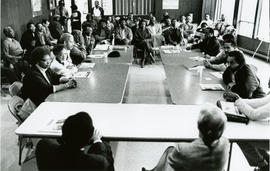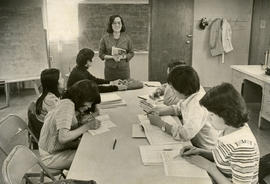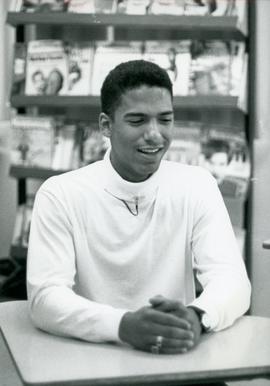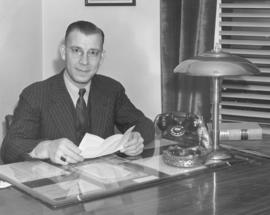The Port of Tacoma was established on November 5, 1918. The Pierce County voters elected Chester Thorne, a banker; Edward Kloss, a longshore official; and C.W. Orton, a fruit and dairy farmer, who served as the first three commissioners. (1) The Port initially consisted of 240 acres of land in the Tacoma Tide flats. (1) The first ship to visit the Port was The Edmore. The Edmore arrived on March 25, 1921, to pick up lumber headed for Japan.
Advocates for public control of waterfront areas had existed since the 1890s. Private docks and facilities in Steilacoom, Ruston Way, and Old Town Tacoma had existed since the 1880s because of shipping and railroads. (2) In 1911 the Washington State Legislature passed the Port District Act, enabling counties to establish public port districts. The Tacoma City Council hired Virgil G. Bogue to educate Pierce County voters about the possibilities of a public Port of Tacoma. He designed a plan to develop Commencement Bay and created a Wapato-Hylebos Waterway. The plan connected basins to industrial plants, railroads, warehouses, and highways. The first vote on the issue failed to pass, and the defeat occurred because of the belief that the port would benefit only urban Tacoma businesspeople. (2)
After World War I, the vote passed, and construction on the Port of Tacoma began. Engineer Frank J. Walsh was hired to create a master plan for developing the Port of Tacoma and advocated for the port's first two piers to be on the Middle Waterway. Voters approved the plan in May 1919, and a $2.5 million bond was issued to fund land purchase and construction. (2)
The 1920s were busy years for the Port of Tacoma, with regular vessels visiting the port and continued development, including the Ruston Smelter, Hooker Chemical Company plant, and port commissioners' support of an airport between Tacoma and Seattle. (2) The Great Depression placed pressure on Tacoma's waterfront, slowing down construction projects and tonnage. The port had to cut wages multiple times and reduce rents for businesses leasing land. It was not until after Franklin D. Roosevelt became president that Tacoma's maritime commerce began to recover. (2)
During WWII, the Port of Tacoma assisted the military with troops from Fort Lewis headed to the Pacific theater from the Port of Tacoma piers. Furthermore, materials and goods also left the port destined for US troops. (2) As a result, Tacoma dockers were busier than during the Depression, but employment lagged as Seattle monopolized the region's army and navy business. The increased mechanization on the docks funded by the US military to speed up loading and discharge reduced longshore worker employment. (2) After 1945 and the war ended, the west coast's cargo trade dropped 90 percent. (2)Post-WWII, the Port of Tacoma Commission resumed attracting manufacturers to the Port Industrial District. Soon, Purex, Concrete Technology, Stauffer Chemical, and Western Boat Building were established in the Industrial District. (3) However, the port was still behind its pre-war business levels. Therefore, in the 1950s, the commissioners strove to make more improvements to attract development. For example, the Industrial Waterway was dredged to accommodate larger ships, and the Industrial Waterway Bridge opened in 1953. (3) The real change occurred with the achievement of government funding due to the adoption of the Tibbetts-Abbett-McCarthy-Stratton (TAMS) plan, which emphasized how the Port of Tacoma had easy access to deep water in Commencement Bay. As a result, waterways were extended and widened. In 1959, the port purchased the former Todd Pacific Shipyard from the United States Navy, and the site became the Port Industrial Yard. (3) The port then leased its new property to private companies.
In the late 1960s, the Port of Tacoma built new warehouses and piers for container cargo and continued to expand its land holdings. (3) Port of Tacoma and ILWU members experienced labor and management cooperation, but tensions continued due to increased mechanization and containerization. (3)
Global trade increased at record rates in the 1970s, and the Port of Tacoma benefited from trade with Pacific Rim countries. When the American embargo on trade with the People's Republic of China ended in 1979, China joined Japan, Taiwan, and Korea as trading partners with Washington state. (3) As a result, the port outperformed tonnage moves and revenues from the previous decade.
The Port of Tacoma became a pioneer in trade and transportation history when it opened the North Intermodal Yard in 1981. It was the first dockside railyard on the located on western coast of the United States. The intermodal yards bring modes of transportation together in one location then containers can be transferred across modes. (4) In the 1980s, Mitsubishi joined other automobile manufacturers in shipping vehicles using the Port of Tacoma. Later, the Commerce Department approved the Port's Foreign Trade Zone (FTZ) designation in 1983, and Mazda started using the FTZ site to add U.S.-made accessories to imported vehicles. (4) Additionally, the arrival of Sea-Land and Maersk shipping businesses in 1985 made Tacoma the fastest-growing port in North America. (4)During the 1980s, the Port of Tacoma was involved in negotiations and litigation with the Puyallup Tribe over waterfront ownership. (4) The Puyallup Tribe claimed land in the port, part of downtown Tacoma, Fife, and a stretch of Interstate 5. The tribe stated that the area was their historic land and, in the reservation, established for the tribe in 1857. (4) The tribal members accepted a $162 million land settlement in 1988, and a year later, a federal law was passed approving the settlement. (4) With the negotiations and settlement agreed upon, the Port of Tacoma continued to work with the Puyallup Tribe on development and environmental issues.
In the 1990s, the Port of Tacoma continued to grow as Taiwan's Evergreen Line began serving the Port's Terminal 4. (4) However, while trade increased, large-scale manufacturers disappeared from the Tacoma tide flats. For example, in 1992, Tacoma Boat closed after struggling with bankruptcy. (4) Additionally, in 2000 Kaiser Aluminum smelter closed in 2000 due to power costs and the effects of a long strike. Throughout the 2000s, the port continued to build new facilities while demolishing historic old ones. (4) In October 2003, the 146.5-acre Marshall Avenue Auto Facility opened at the port allowing the Auto Warehousing Company to store and process 20,000 vehicles at a time. (4)
Currently, the port owns about half of the Tacoma Tide flat’s 5,000 acres. "Real estate and marine cargo operations at the port support more than 42,000 jobs and nearly $3 billion in labor income. The port-related activity also generates over $100 million annually in state and local taxes to support education, roads, and police and fire protection for our community." (1) The Northwest Seaport Alliance makes the Port of Tacoma the fourth-largest container gateway in the United States and a primary gateway for trade with Asia and Alaska. (1)




